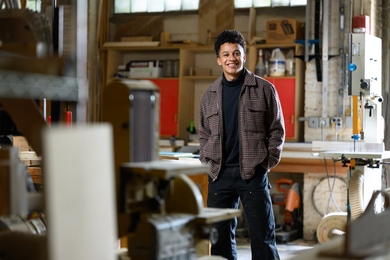A voltmeter hooked up to the MIT Museum Friday night would have registered a giant two-hour spike during the second annual MIT EnergyNight.
Hundreds turned out for the event, which brought together the science, engineering, policy and business communities at MIT and showcased campus energy initiatives.
Engineering Systems Division graduate student Greg Singleton, MIT Energy Club president, welcomed people as they streamed up the entrance corridor of the museum at around 6 p.m., a half-hour into the two-hour event.
Mechanical engineering graduate student and Energy Club event chair Alissa J. Jones organized this year's event, which featured 30 booths and displays from laboratories including the Environmentally Benign Manufacturing Lab and the Earth Resources Lab; companies including Shell Oil, Evergreen Solar and Stellaris Corp.; programs such as the Lemelson-MIT Program; and student efforts such as the Solar Car Team and the Solar Decathlon.
"There are twice as many presenters as last time," Jones said. The goal of the event is to provide an opportunity for people across campus working on unrelated projects to connect and for everyone interested in energy to see the wide range of energy work in progress. "We want people and groups in and around campus to understand what everyone else is doing," she said.
Students, faculty, staff, business professionals and family members attending Family Weekend milled around the museum exhibits, ate hors d'oeuvres, listened to live jazz and talked. Mechanical engineering graduate student Ethan J. Crumlin demonstrated an Electrochemical Energy Lab display of a tabletop fuel cell. "Some people have heard of a fuel cell--here you can see a fuel cell in action," he said. He said he would like people to walk away with a sense of how simple a fuel cell (which does not produce energy but stores it) really is. "A fuel cell is a true enabler," he said.
David Colt, a junior majoring in energy and economics at Reed College, is spending this semester as a visiting student at Harvard and working part-time at the Cambridge, Mass.-based Prometheus Institute for Sustainable Development.
"I'm really excited about all these technologies," Colt said. "I've done research about risks, and far more than terrorism, I think that the biggest risk facing us is global warming." Colt is betting on solar energy for the future. Solar's ability to work independent of a grid will provide a power source for remote villages and give people flexibility, he said.
MIT parents Sammy Munuswamy and Kantha Arumugam of Hagerstown, Md., took in the atmosphere and checked out the MIT Museum exhibits while visiting their son, freshman Hemagiri Arumugam. Both engineers, they said they were intrigued by the latest advances in clean technologies.
The MIT Solar Decathlon team, which will vie against 19 other university teams to design, test and build a house powered solely by the sun that will operate for two weeks on the National Mall in Washington, D.C., in September 2007, was recruiting new members.
A member of the team also described the group's efforts to raise funds by selling "Smoot sticks," a reference to an MIT alumnus, Oliver R. Smoot '62, whose height was used as a unit of measure for the Harvard Bridge. The Solar Decathlon team intends to make all the measurements of its solar house in Smoots.
EnergyNight was sponsored by Cambridge Energy Research Associates, Shell Oil and General Catalyst.
A version of this article appeared in MIT Tech Talk on October 18, 2006 (download PDF).





